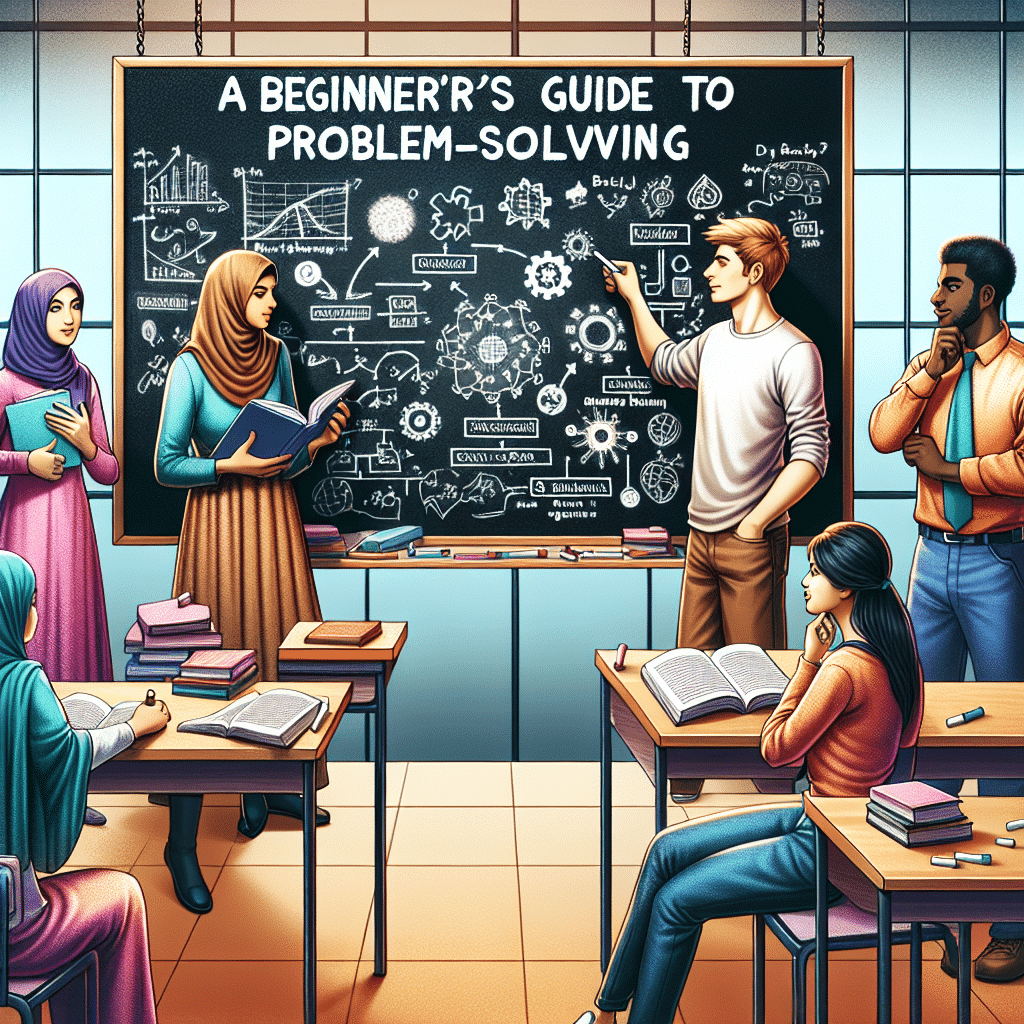
Understanding Problem Solving
Problem-solving is a crucial skill that everyone, especially beginners, can benefit from mastering. Whether you’re facing a complex issue or a simple challenge, being able to effectively solve problems will not only help you overcome obstacles but also boost your confidence and decision-making abilities.
In this guide, we will explore the fundamentals of problem-solving for beginners. We will break down the process into five key steps that will empower you to approach any problem with clarity and efficiency.
Identifying the Problem
In any problem-solving process, the first step is to identify the problem. This may seem obvious, but sometimes the underlying issue may not be immediately apparent. By properly identifying the problem, you can ensure that you are addressing the root cause and not just treating the symptoms.
There are several techniques you can use to identify a problem. One approach is to ask “why” until you reach the core issue. This technique, known as the “5 Whys,” involves repeatedly asking why a problem exists and drilling down to its fundamental cause.
Another method is to gather information through observation and data collection. By carefully observing the situation and collecting relevant data, you can gain a deeper understanding of the problem and its context. This can help you identify patterns, trends, or any contributing factors that may be contributing to the problem.
It’s crucial to involve stakeholders in the problem identification process. Stakeholders are individuals or groups who have an interest in the outcome of the problem-solving process. They may provide valuable insights, perspectives, or information that can aid in identifying the problem. Their involvement can also help ensure that the problem-solving process is collaborative and inclusive.
During the problem identification phase, it’s important to define the problem clearly and concisely. This involves describing the problem in a way that reflects its impact, scope, and any constraints or limitations. A well-defined problem statement helps ensure that everyone involved understands the problem and can work towards a common goal.
In addition to defining the problem, it can be helpful to prioritize the identified problems. Not all problems are equal in terms of urgency or impact. By prioritizing the problems, you can determine which ones require immediate attention and which ones can be addressed later.
Overall, the process of identifying the problem is a crucial step in problem-solving. It sets the foundation for the rest of the process and ensures that you are tackling the right issue. By using techniques such as the 5 Whys, gathering information, involving stakeholders, and defining and prioritizing the problem, you can effectively identify the problem and move on to analyzing it.
III. Analyzing the Problem
After identifying the problem, the next crucial step in problem-solving for beginners is to analyze the problem thoroughly. Analyzing the problem involves breaking it down into smaller components and understanding its underlying causes. This process helps in gaining a deeper understanding of the problem and finding an appropriate solution.
Here are some tips to help beginners analyze a problem effectively:
Define the Problem
Clearly define the problem using specific and concise language. This step ensures that everyone involved understands the problem under consideration.
Gather Relevant Information
Collect all the relevant information and data related to the problem. This may involve conducting research, gathering statistics, or analyzing past trends. Having accurate and up-to-date information is crucial for making informed decisions.
Identify Possible Causes
Identify all the possible causes that might be contributing to the problem. This step requires careful analysis and observation. It is important to consider both internal and external factors that could be influencing the situation.
Identify Patterns or Trends
Look for patterns or trends that might exist within the problem. Identifying recurring themes or commonalities can provide valuable insights into the underlying causes or dynamics at play.
Consider Different Perspectives
Take into account different perspectives or viewpoints when analyzing the problem. This can help in gaining a broader understanding of the situation and potentially uncovering new insights or solutions.
Break Down the Problem
Break down the problem into smaller, more manageable parts. This allows for a more systematic analysis and makes the problem less overwhelming. It also helps in identifying specific areas where improvements can be made.
Ask Relevant Questions
Ask yourself and others relevant questions to gain a deeper understanding of the problem. Questions like “Why is this happening?” or “What are the potential consequences?” can help in uncovering additional information or perspectives.
By thoroughly analyzing the problem, beginners can develop a comprehensive understanding of the issue at hand. This analysis serves as a foundation for generating effective solutions in the next stage of problem-solving.

IV. Brainstorming Solutions
Once you have thoroughly analyzed the problem, it is time to start brainstorming potential solutions. This stage of problem-solving involves generating as many ideas as possible, without judgment or evaluation. The goal is to encourage creativity and generate a wide range of possible solutions.
To effectively brainstorm solutions, follow these steps:
1. Create a supportive environment
Set up a space where participants feel comfortable and safe to share their ideas. Encourage an open and non-judgmental dialogue, where all ideas are welcome and respected.
2. Encourage active participation
Engage all participants in the brainstorming process, ensuring that everyone has a chance to share their ideas. This includes individuals who may be more introverted or shy, as their perspectives can be valuable in finding innovative solutions.
3. Set a time limit
Brainstorming sessions can easily get off track or become unproductive if they go on for too long. Set a time limit for the session to keep the momentum going and maintain focus.
4. Use various brainstorming techniques
There are several techniques you can use to generate ideas during the brainstorming phase. Some common techniques include:
- Free association: Start with a word or concept related to the problem and let your mind wander to generate new ideas.
- Mind mapping: Create a visual diagram to explore different connections and associations related to the problem.
- Role play: Encourage participants to imagine themselves in various roles or perspectives to generate new ideas.
- Reverse brainstorming: Instead of focusing on solutions, think of ways to exacerbate or intensify the problem. Then, brainstorm ways to mitigate or solve those worsened problems.
5. Quantity over quality
During brainstorming, the focus should be on generating a large quantity of ideas, rather than evaluating their quality. Avoid criticizing or dismissing ideas prematurely, as this can stifle creativity and prevent potentially valuable solutions from emerging.
6. Record all ideas
Capture all the ideas that emerge during the brainstorming session. This can be done using a whiteboard, flipchart, or sticky notes. It is important to document every idea, as even seemingly wacky or far-fetched ideas can sometimes inspire more practical and innovative solutions.
By following these steps, you can effectively brainstorm solutions to the identified problem. The next step is to move on to implementing and evaluating the solutions, which will be discussed in the following section.
Implementing and Evaluating Solutions
Implementing
After brainstorming and selecting a solution, the next step is to implement it. This involves putting the chosen solution or combination of solutions into action. It is important to consider any necessary resources, time, and effort required to implement the solution effectively.
One key factor in implementing a solution is creating a detailed plan or roadmap. This plan should outline the specific steps needed to carry out the solution. Breaking down the implementation process into smaller, manageable tasks can help make the overall process more organized and achievable.
It is also crucial to communicate and collaborate with any individuals or teams involved in the implementation. Clear and effective communication ensures that everyone understands their roles and responsibilities, reducing the risk of misunderstandings or delays.
Evaluating
Once the solution has been implemented, it is important to evaluate its effectiveness. This involves assessing whether the solution has successfully resolved the problem or improved the situation.
Evaluation can take various forms, depending on the nature of the problem and solution. It may involve gathering feedback from stakeholders, conducting surveys or interviews, monitoring key metrics or indicators, or analyzing data.
When evaluating a solution, it is important to compare the actual outcomes with the expected outcomes. If the solution fell short of the expected results, it may be necessary to revisit the problem-solving process and consider alternative solutions.
Continuous evaluation is important to ensure that the implemented solution remains effective over time. Problems may evolve or new challenges may arise, requiring adjustments or modifications to the solution. Regularly reviewing and assessing the solution’s success allows for ongoing improvement and adaptation.
Conclusion
Implementing and evaluating solutions are crucial steps in the problem-solving process. By carefully planning and executing the implementation and regularly evaluating the effectiveness of the solution, beginners can develop their problem-solving skills. Remember that problem-solving is an iterative process, and learning from both successes and failures is key to becoming a proficient problem solver.
Summary
Problem-solving is a crucial skill for beginners to develop, as it helps them tackle challenges and find effective solutions. Understanding the problem is the first step, as it allows for a clear identification and analysis of the issue at hand. Analyzing the problem involves breaking it down into its components and understanding the root cause. Brainstorming solutions expands the possibilities and allows for creative thinking, while implementing and evaluating solutions helps determine their effectiveness.
In conclusion, problem-solving for beginners involves a systematic approach that includes understanding, identifying, analyzing, brainstorming, implementing, and evaluating solutions. By following these steps, beginners can develop their problem-solving skills and effectively overcome challenges in various aspects of life.






